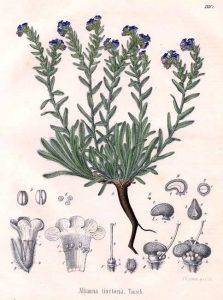
Blush – Alkanna tinctoria L.
Description of blusher:
Alkanna tinctoria L. (Old or other familiar names: sand blush, red, lamb’s blush, wild blush, blusher root, paint root) Borrageae – Borraginaceae Blush is a perennial plant. It has a red root. Underground stems, which are the same red colour as the root, are thick and have a scaly surface. Above ground stems are drooping, very hairy. A very large number of stems emerge from a single stalk. The leaves are also very hairy, scattered, lanceolate, the lower ones with a wedge-shaped lanceolate node. Flowers are blue and red, rarely white or yellow. The blush blooms from April to late June, sometimes a second time in autumn.
Occurrence:
In our country, the blusher is found on the grassy sand plains and quicksands of the lowlands, mainly between the Danube and the Tisza.
Use of blusher:
The root of the blusher is found in the Danube valley and in the southern part of the Danube valley radix alkannae it is sold under the name. It is used to dye oil, ointment, lip balm and liquor, and is also used to detect fats and as a substitute for litmus. It turns blue with alkali and returns to its original blood red colour with acid. Wine spirit dissolves it and turns the fat a beautiful red (it was used to make alkanna red), but only gives water a faint brownish colour. The blushing root is a sought-after commodity. The bark of blusher root is dark red, thin, fragile and peels easily, so it should be handled with care.
Active ingredient:
A red dye substance called alkannin.
How to take:
The blush root should be dug up in dry weather. The above-ground parts should be cut off and discarded, but the root should be cleaned of soil, sand and air in an attic and carefully dried. The better the blush root is cleaned from the parts above the bark, the more valuable the root. When digging up the root, great care must be taken not to damage the bark, because the most valuable part of the blush root is the bark, which contains most of the dye, and the bark peels and crumbles easily. Care should be taken when rotating and packing the root to prevent the bark from wearing off. 4 kg of fresh root will produce 1 kg of dry root. Source: Dr. Ferenc Darvas and Dr. Gyula Magyary-Kossa,Domestic herbs, their production, marketing, effects and medicinal uses Béla Páter, Wild medicinal plants, their production, use, distribution, and marketing
